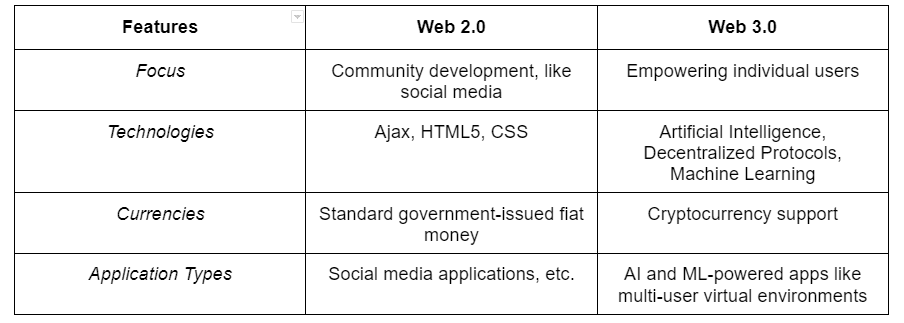Before finding out more about the future of the internet and Web 3.0, we need to understand the humble beginnings.
In simple terms, anything we call a part of the internet can be associated with the word “web.” It can be a site, a page, access, security, or even a camera, and it will ultimately tie up with the term “web” or “WWW” perfectly. Everything we do on the internet works on the interconnected web of servers and local computers.
However, experts also associate the term World Wide Web with numbers. This web is the forgotten Web 1.0. Web 2.0 is definitely on everyone’s lips because it occupies a dominant position today. Of course, Web 3.0 came into use not long ago but is widely used in certain circles while still very timidly displacing its predecessor.
What is Web 1.0?
Web 1.0 was the first-generation advancement of human connectivity using information technology. It was a static form of data transmission, with no video content and a page format that looked more like a pamphlet page—all that was about to change in 2004 when the second generation of the web came out.
What is Web 2.0?
Web 2.0 ushered in a new medium in the way humans connected and interacted. It was separate and distinct from every other that preceded it, including traditional print and video. Instead of just static websites that push information to users, Web 2.0 introduced new forms of interactivity. Concepts such as blogging became popular, and social networks emerged with Friendster, MySpace, and eventually Facebook.
What stands out with the advent of Web 2.0 are the technologies revolutionizing the online experience. Technologies such as Ajax (Asynchronous JavaScript and XML) and CSS (Cascading Style Sheets) completely changed how the web worked.
What is Web 3.0?
Web 3.0 or Web3 can only be loosely defined at this development point, mainly because there is a lack of standardization and research. There is a debate about who coined the term Web 3.0 or Web3. Berners-Lee used Web 3.0 to describe what he referred to as a Semantic Web in 2006, while Ethereum co-founder Gavin Wood first used Web3 in 2014 in cryptocurrency.
As a result of no clear direction, what we see people talking about Web3 is the concept of decentralization. Rather than the same centralized approaches to connectivity and data that are the basis of both Web 1.0 and Web 2.0, Web 3.0 is built on peer-to-peer and consensus algorithms as the foundation. Blockchain technology is a crucial part of the distributed consensus for Web 3.0, hence the popularity of jargon such as decentralization and total privacy.
When talking about decentralization, we cannot omit the mention of cryptocurrency. The race to attain the most non-fungible tokens (NFTs) ensued partially because of crypto. NFTs provides another way to create, manage and own assets using blockchain technology, and Web3 has become a safe mode where wealth transactions can happen without direct influence by a third party.
The use of AI to enable workflows, automation, and overall user experience is another crucial hallmark of the emerging world of Web 3.0. AI helps to promote the scalability and performance of the web itself, as well as powering new forms of intelligent search and interactions.
Web 2.0 vs. Web 3.0: What Made the Difference?
Before understanding the difference between Web 2.0 and Web3, we need to dissect their core features to know the division better.
We will see how both ways of internet usage respond differently to the same conditions in the following comparison:
Significant Difference between Web 2.0 and 3.0
Web 2.0 and Web 3.0 are similar technologies with similar backgrounds, but they approach challenges differently. The fundamental distinction is that Web 2.0 focuses on reading and writing content, whereas Web 3.0 focuses on creating content (Semantic Web). The latter is much better, utilizing technology to facilitate information interchange amongst web users while enhancing cybersecurity.
While Web2 aims to connect people, Web3 combines this data with increasing trust. It happens because of decentralization. More differences are listed below:
Content Ownership
With Web 2.0, the network assumes control for information storage, causing access issues and concerns about the anonymity and protection of online data. Web 3.0 solves this problem by letting data be exchanged in several locations simultaneously.
Speed
Web 2 transfers are quicker than Web 3 transfers. Web 2 scans for information kept in a fixed place, generally on a single server, using HTTP in unique web addresses. Web3, on the other hand, assigns ownership to numerous others (decentralization).
Application
Web2 includes podcasts, social bookmarking, blogs, RSS feeds, and video sites. Web3 incorporates AI and machine learning-powered dApps, virtual worlds, and 3D portals.
What are the benefits of Web3?
The decentralized structure of Web3 is its primary advantage or value for users. Sadly, Web3 will not reward centralized networks in the next generation of the internet.
A democratic atmosphere where spending is more transparent thanks to publicly distributed ledgers will be fair and trustworthy. Corporate corruption will gradually decrease as a result of this. It is fair to say that Web3 has the potential to improve corporate and government operations. However, due to the scale of the shift, it will almost certainly invite criticism.
While decentralization is one of the most significant benefits that Web3 could offer, the other ones include:
More privacy
Web 3.0 will prioritize security and privacy over surveillance and control, as users will have complete control over their data rather than a tech giant. They will have the option of sharing or keeping the information secret as they see fit.
Security
Due to blockchain technology and its autonomous structure, it will also be safer than prior internet versions. Hackers will find it exceedingly tough to exploit the network. The system will log their activities even if they do. In a decentralized system, hacks are still plausible, although most blockchains have developed defenses against such an occurrence.
Ubiquity
Multiple apps may access data, each device is linked to the web, and anyone can access services anywhere.
Connectivity
Data is intimately associated with Web 3.0 due to semantic content, leading to an improved user experience that goes to a new level of connectivity that harnesses all accessible data.
Conclusion
To use an analogy from the movies, if Web 1.0 represented the black-and-white movie era, Web 2.0 would be the age of color/basic 3D. In contrast, Web 3.0 would be immersive experiences in the metaverse.
Just as the 2010s were the decade when Web 2.0 became the dominant force in the global business and cultural landscape, it might be Web 3.0’s turn in the 2020s.
If you want to know more about how software companies work to make Web3 a reality, visit the website section of our blockchain services here.







